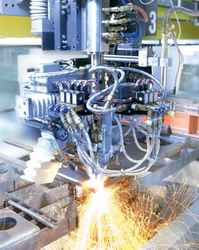
Posted to News on 17th Jul 2015, 11:06
Solenoid valves - some are more equal than others
Process control throughout a vast array of industries relies heavily on the humble solenoid valve and its ability to perform both reliably and efficiently. Michael Hannig, Global Product Manager for Solenoid Valves at Brkert Fluid Control Systems, looks at the improvements in design that have allowed an increasing number of processes to rely on this essential device.

Over 90 per cent of all solenoid valves are equipped with single coils, the simplest of all coil types, which uses an enamelled copper wire wound on a coil bobbin. Brkert coils are designed for continuous operation and are always coated with an insulating mass to ensure high electrical and mechanical protection. For applications involving ambient temperatures up to 250degC, anodised enamelled aluminium wires are used to ensure reliable operation.
Development of the basic design principles has led to reduced energy consumption with the introduction of the double coil design. This uses two independent windings with high and low power. The high-power coil opens the valve and then integrated electronics switch over to the low-power coil to provide the holding force.
As many industries look to reduce the footprint of a variety of control processes, so there is a need to develop smaller control devices that still provide the necessary power and energy savings. Brkert has addressed this requirement with the introduction of the TwinPower solenoid which uses two parallel windings on the coil yoke. The integrated electronics switch the coils from parallel to series connection, which reduces the holding power to 25 per cent of that required for opening the valve.
The design of the coil and its operation has a direct effect on the performance of the valve. The latest energy saving designs allow the coil to be overexcited to open the valve and within half a second, the current is reduced by 95 per cent, which is still sufficient to hold the valve in the open position. The cumulative effect of this type of feature can have a significant impact on the energy required for process control. Increased reaction speed, energy saving and reduced size are all themes that are expected to continue to influence valve design into the future, as are more specialised applications.
If the production process involves liquid food products, the plastics and elastomers used should also conform to the local food and hygiene regulations. In addition, some processes require a cleaning cycle to be performed in between production processes and so the data is also required for this procedure as well to ensure there is no undue material degradation caused by steam or cleansing chemicals.
Specialised applications
Some applications involve potentially explosive atmospheres and therefore any equipment operating in this environment must have been certified to the appropriate ATEX directives. Similarly, components for other specialised applications such as cryogenic systems, must be designed to not only withstand the extreme temperature but continue to operate reliably.
Manufacturers such as Brkert not only design a comprehensive range of solenoid valves to cover both standard and specialist applications, but also manufacture every component which includes the machining of the valve body, the winding of the coil and the injection moulding of the coil encapsulation. In this way, Brkert has control over every aspect of the valve and can therefore guarantee performance.
The testing of individual components and complete valves is a continuous process, partly to ensure continued compliance with a wide range of certification, but also to ensure that the high quality standards are being maintained. In this way the customer can be sure of reliable operation, even in harsh operating conditions.
On the face of it, selecting a solenoid valve appears to be a simple enough decision; however, making the right choice requires an in-depth knowledge of the process under control as well as expertise in the materials and designs available. By combining the knowledge of the process engineer with the fluid control experience of a manufacturer, customers can be assured of a high quality product that will deliver long-term reliability while also complying with the appropriate industry standards.
With over 60 years' experience in the design of solenoid valves, Brkert continues to improve the technology and the materials used in their construction. The expertise in designing and specifying components for fluid control systems is available to every customer, ensuring that both the component and the application will perform as designed.
Follow the link to watch a video about solenoid valves, and for further information please visit www.burkert.co.uk.
Fluid Control Centre
1 Bridge End
GL7 1QY
UNITED KINGDOM
+44 (0)1285 648720






























